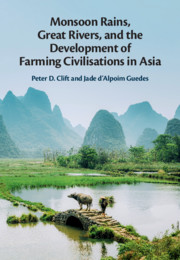Book contents
- Monsoon Rains, Great Rivers, and the Development of Farming Civilizations in Asia
- Monsoon Rains, Great Rivers, and the Development of Farming Civilizations in Asia
- Copyright page
- Contents
- Acknowledgments
- 1 Introduction
- 2 Temporal Variations in the Asian Monsoon
- 3 Monsoon and Societies in Southwest Asia
- 4 Origins of a Uniquely Adaptive Farming System:
- 5 Dryland Farming in the Northern Monsoon Frontier
- 6 Recent Changes in Monsoon Climate
- 7 Future Monsoon Predictions
- References
- Index
4 - Origins of a Uniquely Adaptive Farming System:
Rice Farming Systems in Monsoon Asia
Published online by Cambridge University Press: 17 December 2020
- Monsoon Rains, Great Rivers, and the Development of Farming Civilizations in Asia
- Monsoon Rains, Great Rivers, and the Development of Farming Civilizations in Asia
- Copyright page
- Contents
- Acknowledgments
- 1 Introduction
- 2 Temporal Variations in the Asian Monsoon
- 3 Monsoon and Societies in Southwest Asia
- 4 Origins of a Uniquely Adaptive Farming System:
- 5 Dryland Farming in the Northern Monsoon Frontier
- 6 Recent Changes in Monsoon Climate
- 7 Future Monsoon Predictions
- References
- Index
Summary
The farmers who domesticated and grew rice throughout history developed expert knowledge that successfully allowed them to operate farming systems that are the most productive in terms of calories per hectare worldwide. Throughout both the historic and prehistoric record, Asian rice farmers have developed a dazzling array of techniques to deal with the climatic variations and changes in sea level and river evolution. Southern China is less impacted by changes in rainfall and precipitation than Northern China or South Asia. Humans have, however, constructed a unique niche for this aquatic plant, moving it into areas well outside of its natural range. This chapter outlines how humans first domesticated rice and controlled rivers and mastered the irrigation systems that support it.
- Type
- Chapter
- Information
- Publisher: Cambridge University PressPrint publication year: 2021

